

With Mars the closest in years, I was finally able to take decent images. The seeing cooperated for some long periods, so I was able to take some good sequences (to be converted into a movie). Because Mars is (at best) only about 30 degrees above the horizon this year, the seeing limits the resolution. All images were taken with a 9" Newtonian, using the AO-2 to project to F/60 onto an SBIG ST-7E camera with SBIG color filter wheel. The single exposures ranged from 0.3 seconds to 1 second for each color. MaxIm DL software was use to perform maximum entropy processing, color combining, and unsharp masking. The processing was limited to assure no artifacts were generated. Some residual color on the edges is due to atmospheric turbulence making the different color frames slightly different in shape and size.
The first image in this frame is when Mars was very low on the horizon; the last image is Mars at its highest. After this last image, fog came in, preventing a longer series. These images were the best of hundreds taken on June 16, 2001. The figures are labeled with the central meridian.
Mars June 20, 2001
Turbulence and clouds are still a problem, but two good images survived the selection process. Each are composed of 0.5 sec exposures with each color filter.
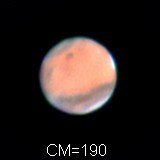
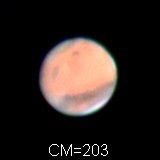
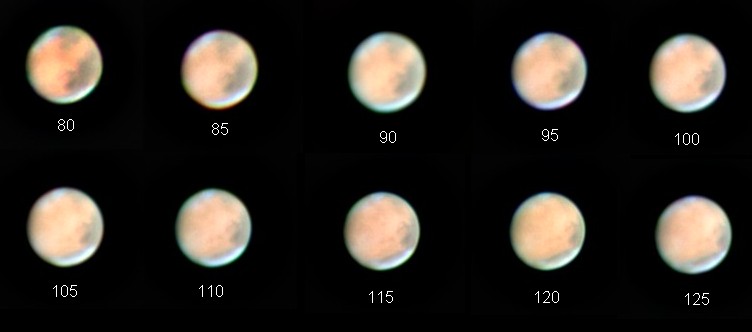
The labels under each image gives the central meridian; these images were taken late in the evening of June 30, 2001 from San Diego. The seeing was average, with slight rippling seen along the edges. The evening was relatively cloud-free until about midnight, when the ocean fog rolled in. The earliest image had some low clouds near the horizon, which apparently increased the contrast! Occasional clouds around CM=120 also affected the different color exposures, but I tried to correct them manually to get the same color in all the images.
Most of the images here are 1 second exposures through RGB filters, combined with MaxIm DL after maximum entropy deconvolution and unsharp masking. Care was taken to not generate any artifacts and maintain visual quality. (CM=80 used 0.5 sec exposures and CM=90 used 4 second exposures.) The planet is 98% illuminated, and the terminator on the left side is noticeably softer than the fully-lit right side.
Dust Storm on Mars!

Starting in late June, a dust storm located at CM=270 spread over the entire globe in early July, obscuring much of the surface detail. The image here was taken at 9:00 PDT (CM=325) on July 13, 2001. The image exposures and processing was identical to that done on the June 30 series above, with similar seeing. The highest contrast feature on Mars, Syrtis Major (easily seen on the left side, just rotating into the field of view in the June 16th images), is just visible in the upper right side of this image. Only about an hours worth of images were taken this evening, with the ocean fog rolling in before the planet got above 28 degrees altitude. The planet is only 95% illuminated, and an oval shape is more apparent, in addition to the soft terminator edge.
July 20, 2001 - Dust Storm still here...
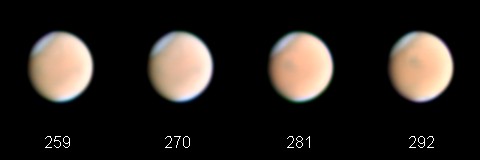
A week later, and the dust is still widespread. These images were taken as usual; 1 second exposures in each color, combined and processed with Maxim DL. Syrtis Major is barely visible in the center of the later images.
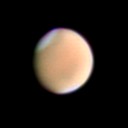
Central meridian = 194. Same exposure as before; 1 second in each color. Compare the detail and Mars diameter with about the same CM on June 20, 2001, shown above.
August 4, 2001; Dust Storm beginning to dissipate?
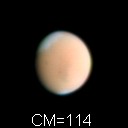
Central Meridian 114. While there are no well-defined features on this side of the planet, the darker surface color is starting to show through the yellow dust. On the left side, near the top but below the white polar hood, a very small dark spot is visible (on this and other images taken about the same time). This is apparently Nix Olympia showing through the dust.
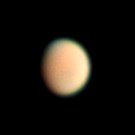
Central Meridian 336 degrees. The day was very hot, and especially bad seeing resulted this evening. The gibbous phase is becoming more apparent, but essentially no surface features are evident. Exposures 1 second, maximum entropy and unsharp masking applied, but to little advantage.
Mars - August 21, 2001
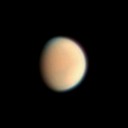
Central Meridian 321. Seeing was still pretty bad near the horizon, but better than Aug 18. The polar hood is getting smaller, and the dust storm is still a problem. Unless the dust storm abates very quickly, no more images of Mars may be posted.
Mars and Phobos
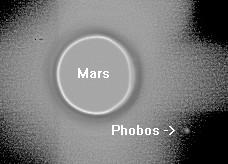
On June 30, before Mars reached the meridian, I took four 20 second exposures to try to image Phobos. This exposure was the longest that the green filtered exposure would accept without blooming the CCD; if saturation would not have occurred, the pixel count would have been about 100,000 counts. After flat-fielding the images, all four frames were averaged, then processed with a non-linear stretch to prevent the glare from Mars from washing out Phobos. This might be the first-ever image of Phobos taken by an amateur astronomer without the aid of an occulting disc or special equipment. Much of the credit goes to the great CCD cameras now available to anyone. If anyone knows of an earlier image, I would like to see it!
NOTE: an alert reader noted that the Phobos image is mirror reversed right-left. Since my telescope has a tertiary mirror, all raw images are reversed, and sometimes I forget to undo the reflection.
Mars and Deimos
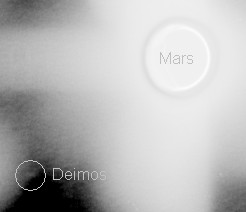
On July 28, 2001, a total of 50 images over a 15 minute period, each 10 seconds long, were made through a green filter. The image here is the average of all 50 frames, with the central exposure at 9:57:20 PDT (UT-7hr). According to Guide7, Deimos should be 143 pixels to the left and 117 pixels down from Mars. The blur circled in the image is about 146 pixels to the left and 116 pixels down! Possible errors are in the pixel scale factor and locating the center of Mars. The moon is streaked because of some RA drift in individual images as well as the difficulty in aligning the 50 images.
According to some rough estimates using the magnitudes of Mars (-1.5) and Deimos (+12.4) given by Guide7, and assuming they are the same color, then Deimos should have been about 10 times brighter. This is unexpected, and made finding the moon a little more difficult. The image above is stretched using DDP in MaxIm DL, but no other processing was used.
The effect of low altitude on Mars this season is shown in this series of images and movie made June 17, 2001. The seeing was below average, and Mars was only 21degrees above the horizon for these 0.11 second exposures through a red filter. (CM = 210). Click on any of these images to bring up an AVI movie showing the turbulence in near real time.
The bottom image is the average of the 16 best frames in the series of 50 images in the movie.
All text and images are owned by Stellar Products, 1992-2003. Any use by others without permission of Stellar Products is prohibited.
Return to the Image Gallery index page
Return to Stellar Products home page